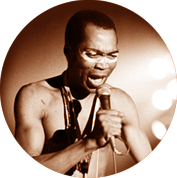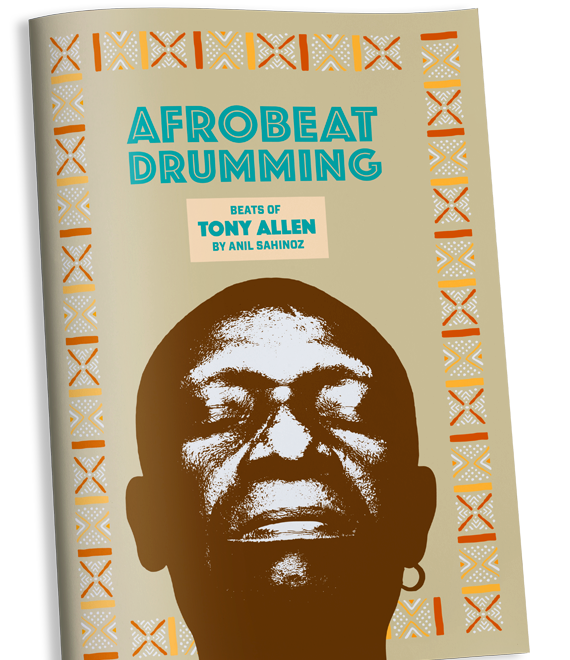Secrets of Afrobeat: Dissecting Tony Allen’s Subtle and Unique Style
 Afrobeat, as created by the late Nigerian musician Fela Anikulapo Kuti, is a captivating musical genre full of subtlety. On first listen, you may think you understand what’s going on, but once you sit down to play the parts, whether it’s along with a recording or live with a band, a whole new world opens up.
Afrobeat, as created by the late Nigerian musician Fela Anikulapo Kuti, is a captivating musical genre full of subtlety. On first listen, you may think you understand what’s going on, but once you sit down to play the parts, whether it’s along with a recording or live with a band, a whole new world opens up.
The signature Afrobeat sound surfaced after Fela took a trip to the United States in 1969, during which he discovered the power of bebop and free jazz and began finding his voice of sociopolitical protest. In the years prior, Fela had a career as a highlife musician and had already begun to incorporate soul-music sounds into his compositions. Upon his return to Africa, he realized the potential in bringing together the gritty funk of James Brown and Geraldo Pino, the jazz of Guy Warren and John Coltrane, and the swinging highlife music of Nigeria’s Ambrose Campbell. The resultant sound was a true melting pot of styles.
- Publication: Modern Drummer: MD
Author: Arntzen, Miles
Date published: January 1, 2014
Language: English
PMID: 78640
ISSN: 01944533
Journal code: MDDR
Fela Kuti may have had the mind to bring together these different influences, but it was his drummer at the time, Tony Allen, who was the one responsible for locking it all up tight. Through his effortlessly conversational and deeply moving style, Allen was able to hold together a band of guitars, basses, percussion, horns, vocalists, and dancers with incredible lightness.
In this article we’ll break down Afrobeat drumming into two main ideas that permeate through Fela’s catalog. We’ll begin with the clave and the way Allen applies 3-2 and 2-3 clave rhythms to the drumset. We’ll also touch on the secret weapon of Afrobeat drumming: the hi-hat.
The final section highlights Allen’s unique fills and groove variations and his extraordinary use of dynamics. When going through these patterns at the drumset, be sure to relax.
THE CLAVE
Most of Allen’s drum parts are based on the clave. This makes sense with the rest of the band, as the guitar, bass, horns, and percussion also revolve rhythmically around the clave. All of the rhythms the band plays are phrased in a certain way that highlights the tension and release within the seemingly simple clave pattern. Here are a few examples.
“I No Get Eye for Back,” from Alagbon Close
The clave is embedded in Allen’s groove over the course of one bar. Tony indicates the clave most clearly at the very beginning of the song, where he’s laying down a simpler groove without much embellishment. The snare articulates the three side of a 3-2 clave.
In the first nine bars of the tune, the only element that changes is the hi-hat. One key to playing Afrobeat music is to keep the hi-hat foot pumping on the offbeats. When the right hand hits the hi-hat as the foot is releasing, a splashy hi-hat sound results.
Also note that in the ninth bar Allen varies the snare and kick pattern to anticipate the horns’ entrance. This is a subtle yet extremely effective way of building anticipation without playing an obvious fill. (0:00)
“Alagbon Close,” from Alagbon Close
The clave in this song has switched to 2-3. Don’t be fooled by this groove-the snare hits on beats 1 and 3. The kick drum is now defining the clave, emphasizing the three side in every bar.
The excerpt included here is from when the drums first enter. Allen hits beat 1 on the kick drum and cymbal and lets the groove hang for two beats, with just his hi-hat foot keeping time on the offbeats. By the second bar, he has settled into the switched groove. Note the drop-something that’s found in many of Fela’s songs-that occurs in bar three. Fela plays a theme line on the keyboard that Tony quickly responds to with a hit on the snare and hi-hat. (1:39) “Upside Down,” from Upside Down
“Upside Down” features a busier kick pattern that plays tag with the snare drum. The tension and release within the three side of the clave is felt heavily here. The kick and snare play with each other in a way that hints at a triplet. Additionally, Allen places emphasis on the of beats 2 and 4 with his hi-hat, giving the pattern a feeling of rolling over onto itself.
The kick drum emphasizes beat 1 but also touches the second 16th note, which grooves hard with the shekere part. This contrasts with beat 3, in which the downbeat is left out and the second 16th note is stated forcefully. “Upside Down” also features a lot of varied hi-hat work. (0:00)
SECRET WEAPON: THE HI-HAT
When playing Afrobeat, it’s important not to allow the hi-hat to become static. It’s the job of the snare and bass drum to hold it down, while the hi-hat dances around the backbeat. Throughout all of these patterns, keep your hi-hat foot bouncing. This will create new sonic possibilities within the grooves that excite and propel the band. With your hi-hat foot bouncing, use your hi-hat hand to accent different 8th notes within the bar.
LEADING THE BAND
Fills are usually looked at as an opportunity to show your stuff, but they also have a key role in any song to usher in new sections. A commonly overlooked aspect of Allen’s drumming is his way of setting things up, whether it’s a horn line, a vocal part, or just a shift in dynamics. When Tony plays a fill, he doesn’t stop what he’s doing. His fills and variations are woven into the groove in creative and subtle ways. One way he achieves this is by always centering his fills on the clave. Here are a few examples.
“Upside Down,” from Upside Down
When your rhythms and inflections align with what’s going on in the rest of the song, a fill won’t stick out in an obvious way, and you’re freed up to express yourself over a longer period of time. In the first two bars of this example, Allen’s inflections hook up nicely with what the guitars and bass are playing.
Once bars three and four hit, Allen catches and plays around the horn lines. The key to keeping it all coherent and moving forward is in the footwork, where the hi-hat pumps the “&” while the kick holds down mostly quarter notes. Try tapping a 2-3 clave rhythm while listening to this passage. (4:05)
“Zombie,” from Zombie
Even in a blazing-fast pattern, Allen finds a way to create tension with a beautiful three-bar lead-in to the huge horn release. Again, tap a 2-3 clave pattern along with the fill to feel the accents. Remember to always keep the hi-hat bouncing on the offbeats. (2:22)
“Open and Close,” from Open and Close
This is an example of Allen’s supreme mastery of dynamics. He uses his drums not only to move bodies on the dance floor but also to call out to the band. With his snare drum as his voice in this early Afrobeat tune, he cues the group to get loud and then soft. This is another example of the classic Tony Allen drop that occurs in many of Fela’s tunes. Tony revs up the engine, draws some attention, and then shuts it all down with a huge whack on the snare drum. (7:19)
STOP COUNTING!
Once you get the basic drum patterns down, try to forget about counting through the bar. Breathe with your fills and your accents. After playing these grooves for a while, you might find a tendency to revolve your playing around the offbeats. Go with it! That helps create a push-and-pull effect, which propels the groove forward. Keep your feet marching and experiment playing freely over them, disregarding where the bar starts and ends.
Author affiliation:
Miles Amtzen is a New York City-based drummer who tours and records regularly with Antibalas, EMEFE, and Superhuman Happiness.

Many tunes of Tony Allen and Fela Kuti
are represented in new book of Anil Sahinoz
‘AFROBEAT DRUMMING’.
This book is basically
about decoding and notating
the grooves of master drummer Tony Allen.